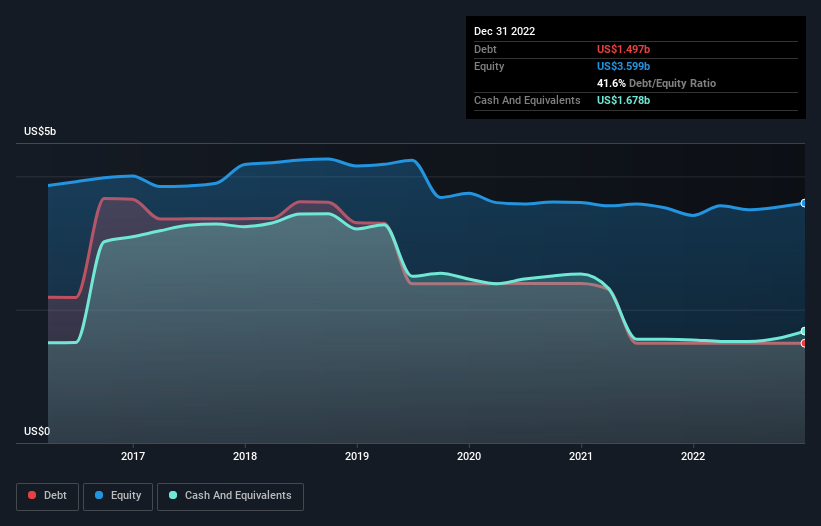David Iben put it well when he said, 'Volatility is not a risk we care about. What we care about is avoiding the permanent loss of capital.' So it seems the smart money knows that debt - which is usually involved in bankruptcies - is a very important factor, when you assess how risky a company is. Importantly, EchoStar Corporation (NASDAQ:SATS) does carry debt. But is this debt a concern to shareholders?
What Risk Does Debt Bring?
Generally speaking, debt only becomes a real problem when a company can't easily pay it off, either by raising capital or with its own cash flow. In the worst case scenario, a company can go bankrupt if it cannot pay its creditors. However, a more common (but still painful) scenario is that it has to raise new equity capital at a low price, thus permanently diluting shareholders. Of course, the upside of debt is that it often represents cheap capital, especially when it replaces dilution in a company with the ability to reinvest at high rates of return. When we examine debt levels, we first consider both cash and debt levels, together.
See our latest analysis for EchoStar
How Much Debt Does EchoStar Carry?
The chart below, which you can click on for greater detail, shows that EchoStar had US$1.50b in debt in December 2022; about the same as the year before. But on the other hand it also has US$1.68b in cash, leading to a US$181.7m net cash position.

How Strong Is EchoStar's Balance Sheet?
According to the last reported balance sheet, EchoStar had liabilities of US$422.8m due within 12 months, and liabilities of US$2.18b due beyond 12 months. Offsetting these obligations, it had cash of US$1.68b as well as receivables valued at US$240.0m due within 12 months. So its liabilities outweigh the sum of its cash and (near-term) receivables by US$681.5m.
This deficit isn't so bad because EchoStar is worth US$1.66b, and thus could probably raise enough capital to shore up its balance sheet, if the need arose. But we definitely want to keep our eyes open to indications that its debt is bringing too much risk. While it does have liabilities worth noting, EchoStar also has more cash than debt, so we're pretty confident it can manage its debt safely.
But the bad news is that EchoStar has seen its EBIT plunge 12% in the last twelve months. If that rate of decline in earnings continues, the company could find itself in a tight spot. When analysing debt levels, the balance sheet is the obvious place to start. But ultimately the future profitability of the business will decide if EchoStar can strengthen its balance sheet over time. So if you're focused on the future you can check out this free report showing analyst profit forecasts.
Finally, while the tax-man may adore accounting profits, lenders only accept cold hard cash. While EchoStar has net cash on its balance sheet, it's still worth taking a look at its ability to convert earnings before interest and tax (EBIT) to free cash flow, to help us understand how quickly it is building (or eroding) that cash balance. During the last three years, EchoStar generated free cash flow amounting to a very robust 82% of its EBIT, more than we'd expect. That puts it in a very strong position to pay down debt.
Summing Up
While EchoStar does have more liabilities than liquid assets, it also has net cash of US$181.7m. The cherry on top was that in converted 82% of that EBIT to free cash flow, bringing in US$181m. So we are not troubled with EchoStar's debt use. When analysing debt levels, the balance sheet is the obvious place to start. But ultimately, every company can contain risks that exist outside of the balance sheet. We've identified 2 warning signs with EchoStar (at least 1 which can't be ignored) , and understanding them should be part of your investment process.
If you're interested in investing in businesses that can grow profits without the burden of debt, then check out this free list of growing businesses that have net cash on the balance sheet.
Valuation is complex, but we're here to simplify it.
Discover if EchoStar might be undervalued or overvalued with our detailed analysis, featuring fair value estimates, potential risks, dividends, insider trades, and its financial condition.
Access Free AnalysisHave feedback on this article? Concerned about the content? Get in touch with us directly. Alternatively, email editorial-team (at) simplywallst.com.
This article by Simply Wall St is general in nature. We provide commentary based on historical data and analyst forecasts only using an unbiased methodology and our articles are not intended to be financial advice. It does not constitute a recommendation to buy or sell any stock, and does not take account of your objectives, or your financial situation. We aim to bring you long-term focused analysis driven by fundamental data. Note that our analysis may not factor in the latest price-sensitive company announcements or qualitative material. Simply Wall St has no position in any stocks mentioned.
About NasdaqGS:SATS
EchoStar
Provides networking technologies and services in the United States and internationally.
Low risk with imperfect balance sheet.
Similar Companies
Market Insights
Community Narratives


